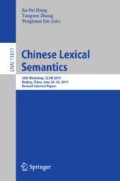Abstract
Emotions can be expressed by the five major external senses of human beings (i.e. vision, hearing, touch, smell and taste) via metaphors. Previous studies have mainly explored the relation between the five senses and emotions from the perspectives of physiology and cognition, and research on the five senses focuses on their semantic meanings. This paper attempts to investigate their relation based on corpus linguistics, centering on sensory verbs and emotional words. It is found that in Mandarin Chinese, five basic emotions (i.e., happiness, sadness, fear, anger, and surprise) can be expressed via olfactory, tactile, visual, and auditory modalities while among these five basic emotions, surprise cannot be expressed through taste.
Access this chapter
Tax calculation will be finalised at checkout
Purchases are for personal use only
References
Lakoff, G., Johnson, M.: Metaphors We Live By. University of Chicago Press, Chicago and London (1980)
Ullmann, S.: Language and Style. Basil Blackwell, Oxford (1964)
Schirmer, A., Adolphs, R.: Emotion perception from face, voice, and touch: comparisons and convergence. Trends Cogn. Sci. 21(3), 216–228 (2007)
Mogg, K., Bradley, B.P.: A cognitive-motivational analysis of anxiety. Behav. Res. Ther. 36(9), 809–848 (1998)
Calvo, M.G., Nummenmaa, L.: Perceptual and affective mechanisms in facial expression recognition: an integrative review. Cogn. Emot. 30(6), 1081–1106 (2016)
Dupuis, K., Pichora-Fuller, M.K.: Use of affective prosody by young and older adults. Psychol. Aging 25(1), 16–29 (2010)
Wang, H., Li, A.: The construction of CASS-ESC (Putonghua emotion speech corpus) and its listening and recognizing experiment. In: Proceedings of the Sixth Modern Phonetics Workshop, pp. 127–132. Chinese Information Processing Society of China (2003). (in Chinese)
Wang, Q., Woods, A.T., Spence, C.: “What’s your taste in music?” A comparison of the effectiveness of various soundscapes in evoking specific tastes. i-Perception 6(6), 1–23 (2015)
Herz, R.S., Schankler, C., Beland, S.: Olfaction, emotion and associative learning: effects on motivated behavior. Motivat. Emot. 28(4), 363–383 (2004)
Oaten, M., Stevenson, R.J., Case, T.I.: Disgust as a disease-avoidance mechanism. Psychol. Bull. 135(2), 303 (2009)
Warrenburg, S.: Effects of fragrance on emotions: moods and physiology. Chem. Senses 30(suppl_1), i248–i249 (2005)
Hertenstein, M.J., Keltner, D., App, B., Bulleit, B.A., Jaskolka, A.R.: Touch communicates distinct emotions. Emotion 6(3), 528–533 (2006)
Zhao, Q., Huang, C.R.: Mapping models and underlying mechanisms of synaesthetic metaphors in Mandarin. Lang. Teach. Linguist. Stud. 1, 44–55 (2018). (in Chinese)
Luo, Y., Zhang, H., Qin, X.: Conceptual integration analysis of synaesthetic metaphors: a case study on synaesthetic metaphors in three hundred poems of the Tang Dynasty. Foreign Lang. Learn. Theory Pract. 164(4), 13–18 (2018). (in Chinese)
Lakoff, G.: Explaining embodied cognition results. Top. Cogn. Sci. 4(4), 773–785 (2012)
Yu, N.: The body in anatomy: looking at “head” for the mind-body link in Chinese. In: Caballero, R., Díaz Vera, J. (eds.) Sensuous Cognition: Explorations into Human Sentience: Imagination, (E)motion and Perception, pp. 53–73. De Gruyter Mouton, Berlin (2013)
Xun, E., Rao, G., Xiao, X., Zang, J.: The construction of the BCC Corpus in the age of big data. Corpus Linguist. 1, 93–109 (2016). (in Chinese)
Turner, J.H.: The evolution of emotions in humans: a Darwinian-Durkheimian analysis. J. Theory Soc. Behav. 26(1), 1–33 (1996)
Chen, Y., Lee, S.Y., Huang, C.R.: A cognitive-based annotation system for emotion computing. In: Proceedings of the Third Linguistic Annotation Workshop, pp. 1–9. Association for Computational Linguistics (2009)
Flavell, J.H.: Theory of mind development: retrospect and prospect. Merrill-Palmer Q. 50, 274–290 (2004)
Golan, O., Baron-Cohen, S., Hill, J.J., Golan, Y.: The “reading the mind in films” task: complex emotion recognition in adults with and without autism spectrum conditions. Soc. Neurosci. 1, 111–123 (2006)
Pell, M.D., Paulmann, S., Dara, C., Alasseri, A., Kotz, S.A.: Factors in the recognition of vocally expressed emotions: a comparison of four languages. J. Phonet. 37(4), 417–435 (2009)
Darwin, C.: The Descent of Man. John Murray, London (1871)
Thompson, E.H., Hampton, J.A.: The effect of relationship status on communicating emotions through touch. Cogn. Emot. 25(2), 295–306 (2011)
Pham, T.T.H.: A study of lower senses sensation words between Chinese and Vietnames and its teaching. Ph. D. dissertation (unpublished). Wuhan University, Wuhan (2017). (in Chinese)
Wendin, K., Allesen-Holm, B.H., Bredie, W.L.: Do facial reactions add new dimensions to measuring sensory responses to basic tastes? Food Qual. Prefer. 22(4), 346–354 (2011)
Robin, O., Rousmans, S., Dittmar, A., Vernet-Maury, E.: Gender influence on emotional responses to primary tastes. Physiol. Behav. 78(3), 385–393 (2003)
Acknowledgments
We would like to thank The National Social Science Fund of China for the financial support on the project (No. 18YJA740030).
Author information
Authors and Affiliations
Corresponding author
Editor information
Editors and Affiliations
Rights and permissions
Copyright information
© 2020 Springer Nature Switzerland AG
About this paper
Cite this paper
Zhou, J., Su, Q., Liu, P. (2020). A Metaphorical Analysis of Five Senses and Emotions in Mandarin Chinese. In: Hong, JF., Zhang, Y., Liu, P. (eds) Chinese Lexical Semantics. CLSW 2019. Lecture Notes in Computer Science(), vol 11831. Springer, Cham. https://doi.org/10.1007/978-3-030-38189-9_62
Download citation
DOI: https://doi.org/10.1007/978-3-030-38189-9_62
Published:
Publisher Name: Springer, Cham
Print ISBN: 978-3-030-38188-2
Online ISBN: 978-3-030-38189-9
eBook Packages: Computer ScienceComputer Science (R0)

